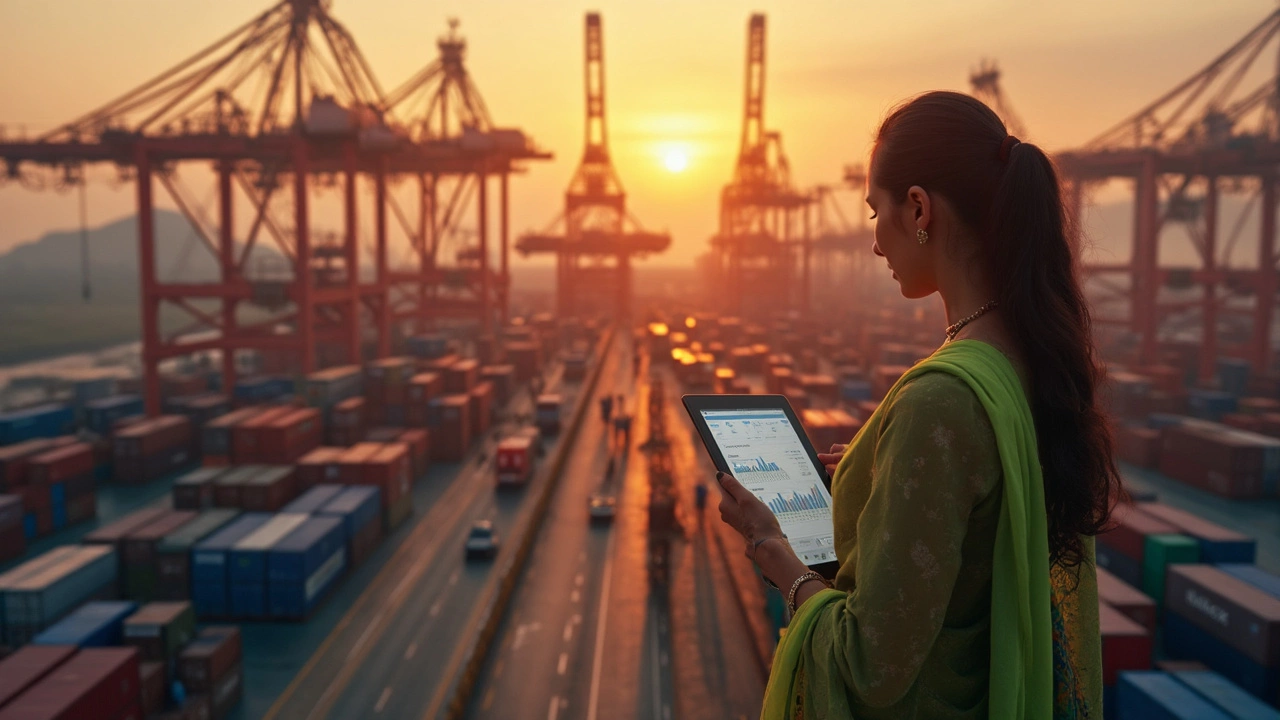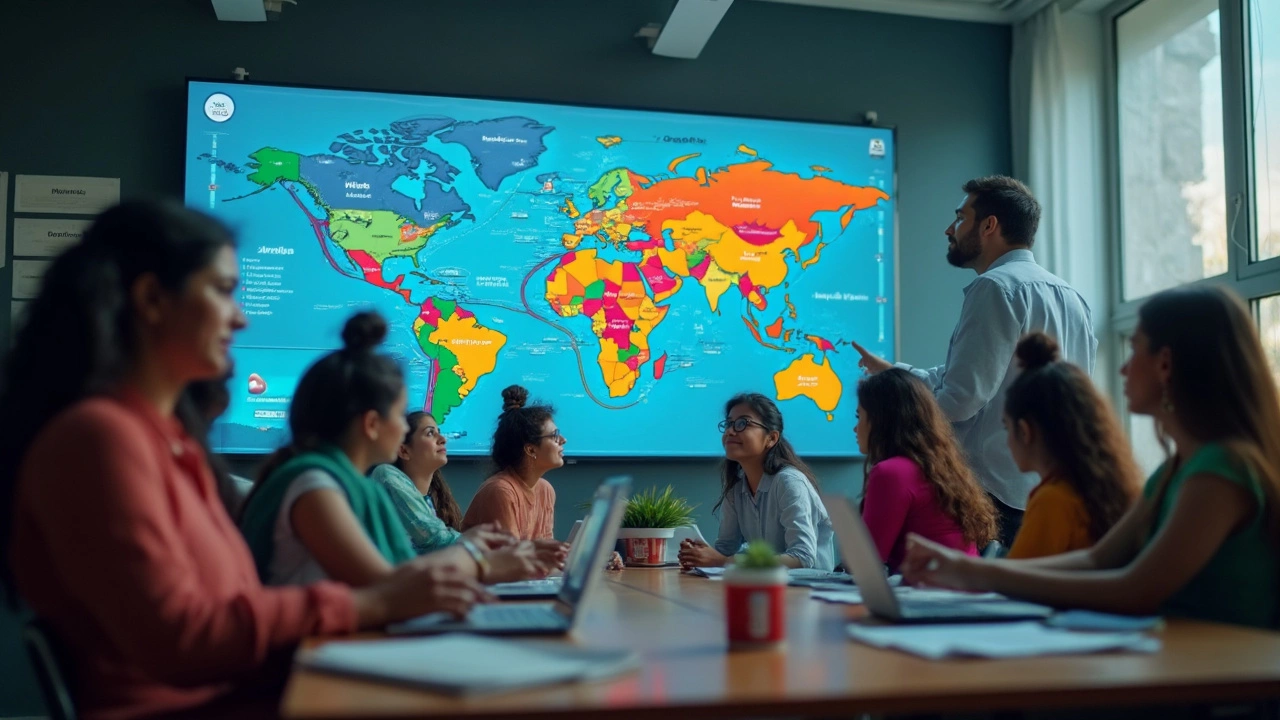Last year, if you checked the numbers, China was still India’s largest trading partner—moving more than $120 billion worth in goods and materials across borders. Just imagine that scale. Every electronics shop, every big pharma warehouse, and even the stuff you order online—there’s a good chance parts or products came through this pipeline. But it’s not a static game. The US, UAE, and a few others, they’re right behind. Just a couple of billion dollars in annual trade value can shift the global pecking order.
For anyone eyeing a career in trade or international business, why does this matter? Because what gets shipped the most, where it's shipped, and who’s buying—this shapes the jobs, internships, and even the course material you’ll get in trade classes across India. If a new trade deal pops up with the EU or Japan next year, you’d better believe textbooks and training modules will get a rewrite. So don’t treat international trade like a faraway news story. It’s close, and it’s always shifting.
- Who's on Top: India’s Leading Trade Partner Now
- How the Trade Relationship Shapes Careers
- What’s Behind India’s Trade Choices
- Smart Tips for Future Trade Professionals
Who's on Top: India’s Leading Trade Partner Now
If you ask around about India's largest trading partner, most folks would guess either China or the United States—and they’d be right. According to trade data from the Ministry of Commerce for 2023-24, China kept its top spot, chalking up a two-way trade value that crossed $113 billion. Pretty wild, considering just ten years back, it was neck-and-neck with the US. But China’s exports to India—think chemicals, telecom, machinery—have just snowballed.
Here’s a table to break down the numbers. You can see who’s in the lead and who’s coming up fast:
| Country | Total Trade (2023-24, USD Billion) | Main Exports to India |
|---|---|---|
| China | 113 | Electronics, Chemicals, Machinery |
| USA | 118 | Oil, Electronics, Gems & Jewelry |
| UAE | 85 | Petroleum, Gold, Electronics |
| Saudi Arabia | 52 | Petroleum, Plastics |
Wait, the US number looks higher—doesn’t that mean the US is on top? Well, the answer depends on what part of the year you're checking, the way re-exports are counted, and currency swings. Some months, the US nudges past China, but over the whole year, China stays number one. Trade isn’t just one-way traffic either: India sends out everything from iron ore to pharmaceuticals right back.
The gap between these top nations is pretty close, though. And that means things can flip quickly if a new trade deal or a global event hits the markets. If you’re in a trade course, keep an eye on these numbers—there’s opportunity where things are constantly moving.
How the Trade Relationship Shapes Careers
How does India’s trading buddy drama matter for your paycheque or the job you’ll get? Quite a lot, actually. When a country dominates as India’s top trade partner—like China right now—it means sectors tied to Chinese imports and exports are more active. For example, in 2023-24, India imported goods worth a whopping $101.7 billion from China, including electronics, machinery, and chemicals. Flip side: we exported $16.7 billion in goods to China, mostly iron ore, organic chemicals, and seafood. That trade gap spells opportunity for people who know how to manage sourcing, logistics, and negotiation for high-volume trade flows.
Check out the impact across several popular career options:
- International trade managers: Companies need folks who speak the language of global regulations, shipping, and customs. Expect to be handling suppliers, negotiating deals, and tracking shifting tariffs.
- Sourcing and supply chain experts: Multinational manufacturers, especially in electronics and pharma, are on the hunt for skilled analysts who know how to ride out international tension or spot a better deal overseas.
- Customs clearing agents: More imports and exports mean more goods crossing ports. These jobs aren’t going anywhere soon.
- Export marketing execs: If you can spot trends—like the rising demand for Indian organic chemicals—then you’re in demand too.
Let’s make the reality clear with some numbers:
| Country | Total Trade (2023-24, in Billion USD) | India's Exports | India's Imports |
|---|---|---|---|
| China | ~118.4 | 16.7 | 101.7 |
| USA | ~118.3 | 77.5 | 40.8 |
| UAE | ~83.6 | 31.6 | 52.0 |
Clearly, jobs linked to these hubs—custom clearance, trade compliance, logistics and international sales—will stay in demand as long as these numbers keep moving. If you’re thinking about what skill to pick up next, watch where the big money flows in this table.

What’s Behind India’s Trade Choices
When you ask why India trades more with some countries than others, the answer isn’t just about distance or who’s got the cheapest prices. It’s a mix of raw need, politics, historic ties, and which industries are booming at home.
Let’s break down a few of the top reasons:
- India needs to import things it just doesn’t have enough of, like crude oil, electronics, and some chemicals. Countries that can deliver these quick and cheap get more trade deals.
- Manufacturing trends play a big role. For example, China exports tons of electronics and machinery to India, which fills gaps for Indian companies making phones, cars, or other gadgets.
- Changes in government policy matter too. Not long ago, India raised tariffs on certain electronics to support local makers. Instantly, trade flows changed and partners shifted around.
- Old trade agreements (like with the UAE or ASEAN countries) make some imports tax-free or cheaper, so Indian businesses naturally buy more from those spots.
Check out how the numbers line up for India’s top imports in 2023:
| Product | Top Supplier | Share of Import (%) |
|---|---|---|
| Crude Oil | Iraq, Saudi Arabia, Russia | 37% |
| Electronics | China, Vietnam, USA | 15% |
| Gold | Switzerland, UAE | 8% |
| Machinery | China, Germany | 7% |
Notice how some countries dominate specific sectors. China’s grip on electronics is the backbone of its trade relationship with India, while Middle Eastern countries top the energy list because of oil. That’s not random—it’s because India’s growth needs fuel, tech, and financial backing, and these partners line up perfectly with that demand.
One tip for anyone getting into trade jobs or course work: Watch for new policies or global trends. For example, if the Indian government suddenly boosts solar energy with incentives and cuts tariffs on solar panels, guess who becomes a top partner? Yep, countries with the best panels. Follow the policy, and you’ll see the trade shifts coming.
Smart Tips for Future Trade Professionals
Starting a career in trade, you can't afford to only watch the headlines. India handles business with dozens of countries, but everyone’s talking about China and the US because together, they make up a huge chunk of India’s trade numbers. Just to give you an idea, in 2023 India's total exports were around $450 billion, with about 17% going to the US and around 7% heading to China. The balance of trade and who’s buying what can change fast, so staying updated matters way more than you’d think.
So, what can you actually do to stay sharp and relevant? Here are a few practical moves anyone thinking about entering the world of India's largest trading partner should keep in mind:
- Track Trade Policies: Changes in government policies or tariffs can completely turn the tables. Look up recent rules—like when India hiked import tariffs on electronic goods, which changed sourcing overnight.
- Follow Real Data: Don’t trust social media for the big stuff. Check out Ministry of Commerce updates, trade bulletins, or even the World Bank website to know exactly who’s trading what.
- Specialize in High-Demand Sectors: Electronics, pharma, petrochemicals, and auto parts are top exports. If you can speak the lingo of these industries, you’re already ahead of the crowd.
- Brush Up Your Negotiation Skills: More trade means more competition and tough deals. Learning how to negotiate international contracts is a big plus—courses often miss this but bosses notice fast.
- Stay Legal: Don’t ignore certifications. Every year, exports worth millions get stuck over missing paperwork. The Foreign Trade (Development & Regulation) Act isn’t just background noise; knowing it can save serious money.
It also helps to see the big numbers in one spot. Take a look at this table—it's fresh data from 2023:
| Country | India's Exports (USD Billion) | India's Imports (USD Billion) |
|---|---|---|
| USA | 78 | 47 |
| China | 16 | 98 |
| UAE | 31 | 53 |
This is your playing field. If you’re serious about a career in trade, match your skills to where the numbers are rising, not falling. And maybe don’t forget to network—most big roles in this business still come through word of mouth and referrals, not just job portals.



